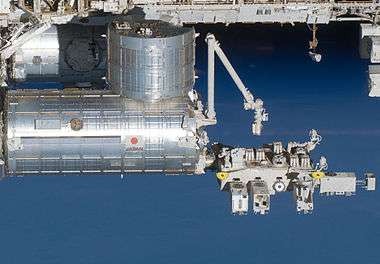Tanpopo (mission)

The Tanpopo mission is an orbital astrobiology project investigating the potential interplanetary transfer of life, organic compounds, and possible terrestrial particles in the low Earth orbit. The purpose is to assess the panspermia hypothesis and the possibility of natural interplanetary transport of life and its precursors.
The experiment, developed by Japanese scientists, started in May 2015 utilizing the Exposed Facility located on the exterior of Kibo, the Japanese Experimental Module of the International Space Station.[1] The mission will collect cosmic dust by using ultra-low density silica gel (aerogel),[2] and will analyze it after returning to Earth. The principal investigator is Akihiko Yamagishi, who heads a team of researchers from 26 universities and institutions in Japan, including JAXA.
Mission
.jpg)
If the Tanpopo mission can detect microbes at the higher altitude of low Earth orbit (400 km), it will support the possible interplanetary migration of terrestrial life.[3] The mission was named after dandelion (Tanpopo) because the plant's seeds evoke the image of seeds of lifeforms flying up to space.
The Tanpopo mission is taking place at the Exposed Facility located on the exterior of the Kibo module of the ISS. It is collecting cosmic dust and exposing dehydrated microorganisms outside the International Space Station while orbiting 400 km (250 mi) above the Earth. These experiments will test some aspects of panspermia, a hypothesis for an exogenesis origin of life distributed by meteoroids, asteroids, comets and cosmic dust.[4] This mission will also test if terrestrial microbes (e.g., aerosols embedding microbial colonies) may be present, even temporarily and in freeze-dried form in the low Earth orbit altitudes.[4]

Three key microorganisms include Deinococcus spp.: D. radiodurans, D. aerius and D. aetherius.[5] Containers holding yeast and other microbes were also placed outside the Kibo module to examine whether microbes can survive being exposed to the harsh cold environment of outer space. Also, by evaluating retrieved samples of exposed terrestrial microbes and astronomical organic analogs on the exposure panels, they can investigate their survival and any alterations in the duration of interplanetary transport.
Researchers also aim to capture organic compounds and prebiotic organic compounds — such as aminoacids — drifting in space.[6] The mission will collect cosmic dust and other particles for three years by using ultra-low density silica gel called aerogel. Some of these aerogels will be replaced every one to two years through 2018.[6]
Analyses
The aerogels will be placed and retrieved by using the robotic arm outside Kibo. The first samples will be returned to Earth in mid-2016.[7] The last aerogels will be placed inside the 'landing & return capsule' in 2018 and ejected toward Earth for retrieval.[4] After retrieving the aerogels, scientists will investigate the captured microparticles and tracks formed, followed by microbiological, organochemical and mineralogical analyses. Particles potentially containing microbes will be used for PCR amplification of rRNA genes followed by DNA sequencing.[8]
Possible escape of terrestrial microbes from Earth to space will be evaluated by investigating the upper limit of terrestrial microbes by the capture experiment.[7]
See also
- Astrobiology
- Bion
- BIOPAN
- Biosatellite program
- EXPOSE
- List of microorganisms tested in outer space
- O/OREOS
- OREOcube
- Stardust mission
References
- ↑ NASA ISS On-Orbit Status 13 May 2015
- ↑ Tabata, M; Imai, E; Yano, H; Hashimoto, H; Kawai, H; et al. (2014). "Design of a Silica-aerogel-based Cosmic Dust Collector for the Tanpopo Mission Aboard the International Space Station". Transactions of The Japan Society for Aeronautical and Space Sciences, Aerospace Technology Japan. J-STAGE. 12 (ISTS 29): Pk_29–Pk_34. doi:10.2322/tastj.12.Pk_29. Retrieved 1 September 2016.
- ↑ Microbe space exposure experiment at International Space Station (ISS) proposed in "Tanpopo" mission. Research Gate, July 2010.
- 1 2 3 "Tanpopo Experiment for Astrobiology Exposure and Micrometeoroid Capture Onboard the ISS-JEM Exposed Facility." (PDF) H. Yano, A. Yamagishi, H. Hashimoto1, S. Yokobori, K. Kobayashi, H. Yabuta, H. Mita, M. Tabata H., Kawai, M. Higashide, K. Okudaira, S. Sasaki, E. Imai, Y. Kawaguchi, Y. Uchibori11, S. Kodaira and the Tanpopo Project Team. 45th Lunar and Planetary Science Conference (2014).
- ↑ Kawaguchi, Y.; Yang, Y.; Kawashiri, N.; Shiraishi, K.; Takasu, M.; Narumi, I.; Satoh, K.; Hashimoto, H.; Nakagawa, K.; Tanigawa, Y.; Momoki, Y.H.; Tanabe, M.; Sugino, T.; Takahashi, Y.; Shimizu, Y.; Yoshida, S.; Kobayashi, K.; Yokobori, S.; Yamagishi, A. (2013). "The possible interplanetary transfer of microbes: assessing the viability of Deinococcus spp. under the ISS Environmental conditions for performing exposure experiments of microbes in the Tanpopo mission". Orig Life Evol Biosph. 43 (4-5): 411–28. doi:10.1007/s11084-013-9346-1. PMID 24132659.
- 1 2 Tanpopo mission to search space for origins of life. The Japan News, April 16, 2015.
- 1 2 Kawaguchi, Yuko; et al. (13 May 2016). "Investigation of the Interplanetary Transfer of Microbes in the Tanpopo Mission at the Exposed Facility of the International Space Station". Astrobiology. 16 (5): 363–376. doi:10.1089/ast.2015.1415. Retrieved 2016-05-29.
- ↑ Tanpopo mission: Astrobiology exposure and capture experiments of microbes and micrometeoroid. (PDF) Yuko Kawaguchi. 2014.
